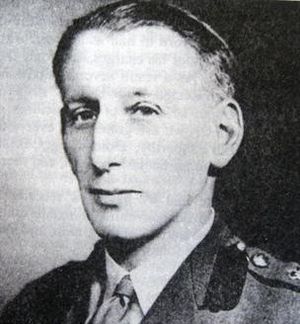Basil Schonland facts for kids
Quick facts for kids
Sir Basil Schonland
|
|
|---|---|
 |
|
| Born | 2 February 1896 Grahamstown, Cape Colony
|
| Died | 24 November 1972 (aged 76) |
| Alma mater | Rhodes University, Gonville and Caius College, Cambridge |
| Awards | Order of Mapungubwe (2002) IET Faraday Medal (1962) Wilkins Lecture (1955) Bernard Price Memorial Lecture (1951) Elliott Cresson Medal (1945) Hughes Medal (1945) Chree Medal and Prize (1943) Fellow of the Royal Society (1938) Order of the British Empire (1919) |
| Scientific career | |
| Fields | Physics |
| Institutions | Atomic Energy Research Establishment |
Sir Basil Ferdinand Jamieson Schonland was a famous scientist from South Africa. He was born on February 2, 1896, and passed away on November 24, 1972. He is best known for his important studies on lightning. He also played a big part in creating radar during World War II. After the war, he became the first head of the South African Council for Scientific and Industrial Research, which helps with science and research in the country.
| Top - 0-9 A B C D E F G H I J K L M N O P Q R S T U V W X Y Z |
Early Life and Learning
Where Basil Schonland Grew Up
Basil Schonland was born in a town called Grahamstown in what was then known as the Cape Colony. His father, Selmar Schonland, was a botanist, which means he studied plants. His father also helped start Rhodes University.
Basil Schonland's Education
Basil was a very smart student. In 1910, when he was only 14 years old, he finished high school at St. Andrew's College. He was the best student in the entire Cape Province. Later, he went on to study at Rhodes University and Gonville and Caius College, Cambridge in England.
Serving His Country
World War I Service
During World War I, Basil Schonland volunteered to serve his country. He joined the Signal Service of the Royal Engineers and worked in France from 1915 to 1918. He was injured during a battle and was recognized for his bravery. He also received an award called the OBE.
World War II Contributions
When World War II started, Basil Schonland was a military officer. He led a group called the South African Special Signals Services. This group was in charge of developing South Africa's own radar system. Radar uses radio waves to detect objects, like airplanes or ships.
In 1941, he went to England to get more equipment for South Africa. While there, he was asked to lead a special research group for the army. This group helped improve how radar was used by soldiers. By 1944, he was a scientific advisor to a very important military leader, Field Marshal Bernard Montgomery. He helped with military operations in England, France, and Belgium. By the end of the war, he had reached the rank of brigadier.
Scientific Discoveries
Studying Lightning
After World War I, Basil Schonland became a research student at Cavendish Laboratory at Cambridge University. There, he studied how tiny particles called beta particles moved.
In 1922, he came back to South Africa and started working at the University of Cape Town. He became a professor of physics. He later moved to Witwatersrand University in 1937 to become the first director of the Bernard Price Institute of Geophysics.
At this institute, he made huge discoveries about lightning. He took many photographs of lightning and studied the electrical fields created by thunderclouds. South Africa has a lot of lightning, which gave him plenty of chances to study it!
After the Wars
Leading Science in South Africa
After World War II, in 1945, Basil Schonland was asked by the Prime Minister of South Africa, General Jan Smuts, to create the Council for Scientific and Industrial Research (CSIR). This organization helps to advance science and technology in South Africa.
He also continued his work as director of the Bernard Price Institute. In 1951, he became the first Chancellor of Rhodes University, a position he held until 1962.
Work with Atomic Energy
In 1954, Basil Schonland became the deputy director, and later the director, of the Atomic Energy Research Establishment in England. This was a very important role in the field of atomic energy.
Becoming a Knight
In 1960, Queen Elizabeth II made him a Knight Bachelor. This means he was given the title "Sir" for his great contributions to science in Britain.
Later Life and Legacy
Retirement and Passing
Sir Basil Schonland retired to his home near Winchester, England. He passed away after a long illness on November 24, 1972.
Awards and Honors
Sir Basil Schonland received many awards for his scientific work and service. Some of these include:
- The OBE (military) in 1919.
- The CBE (military) in 1944.
- A knighthood in 1960.
- The Chree medal and prize in 1943.
- The Hughes Medal in 1945.
- The Elliott Cresson Medal in 1950.
In 1999, he was voted South Africa's "Scientist of the Century." In 2002, he was given the Order of Mapungubwe - Gold class (OMG) after his death, for all his amazing work in science for South Africa.
Schonland Research Centre
To honor his memory, a nuclear physics research center at the University of the Witwatersrand in Johannesburg was renamed the Schonland Research Centre in 1984. This center was founded by one of his students, Friedel Sellschop.
See also
- Harwell Synchrocyclotron

